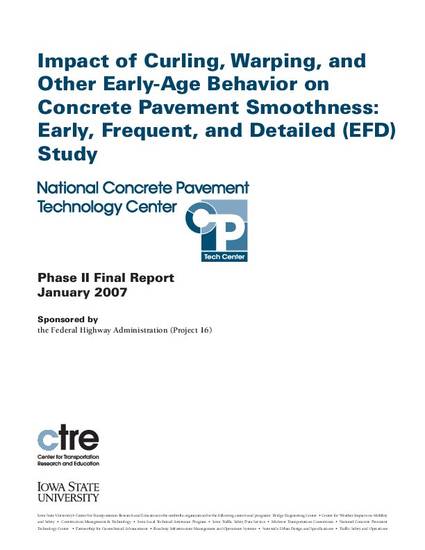
Article
Impact of Curling, Warping, and Other Early-Age Behavior on Concrete Pavement Smoothness: Early, Frequent, and Detailed (EFD) Study
InTrans Project Reports
Document Type
Report
Publication Date
1-1-2007
Disciplines
Abstract
This report summarizes the activities in Phase II of “Assessing the Impact to Concrete Pavement Smoothness from Curling, Warping, and other Early-Age Behavior: Early, Frequent, and Detailed (Project 16).” The purpose of this project is to obtain detailed information about factors affecting pavement smoothness during the critical time immediately following construction by conducting a controlled field evaluation of three concrete pavement construction projects. In Phase II, both field and laboratory testing of the materials and construction process were conducted for two newly constructed Jointed Plain Concrete Pavement (JPCP) test sections; one on highway U.S. 34 near Burlington and the other on U.S. 30 near Marshalltown, Iowa. Extensive pavement profiling was also performed during strategic times after placement. This report fulfills the remaining requirements of Phase II.
As a whole, the data collection effort undertaken by the project team was a success. The result of this project is a large amount of quality data on the early-age effects of curling and warping on pavement smoothness. By using the data from this research and by using the mathematical models developed as part of current FHWA studies and elsewhere, the complex relationships between concrete pavements curling, warping, and other early-age behavior and pavement smoothness were discussed and presented.
This study shows that the curling and warping behaviors at early ages are influenced not only by temperature variation but also by other environmental effects such as the moisture variation, drying shrinkage, and temperature conditions during pavement construction. Within the scope of this project, it can be concluded that measurable changes of early-age pavement smoothness do occur over time from the standpoint of smoothness specifications.
Copyright Owner
Iowa State University
Copyright Date
2007
Report Number
FHWA DTFH61-01-X-00042 (Project 16)
Granting Agencies
Federal Highway Administration, U.S. Department of Transportation
Language
en
File Format
application/pdf
Citation Information
Halil Ceylan, Sunghwan Kim, Dennis J. Turner, Robert Otto Rasmussen, et al.. "Impact of Curling, Warping, and Other Early-Age Behavior on Concrete Pavement Smoothness: Early, Frequent, and Detailed (EFD) Study" (2007) Available at: http://works.bepress.com/halil_ceylan/197/

Phase ΙΙ Final Report